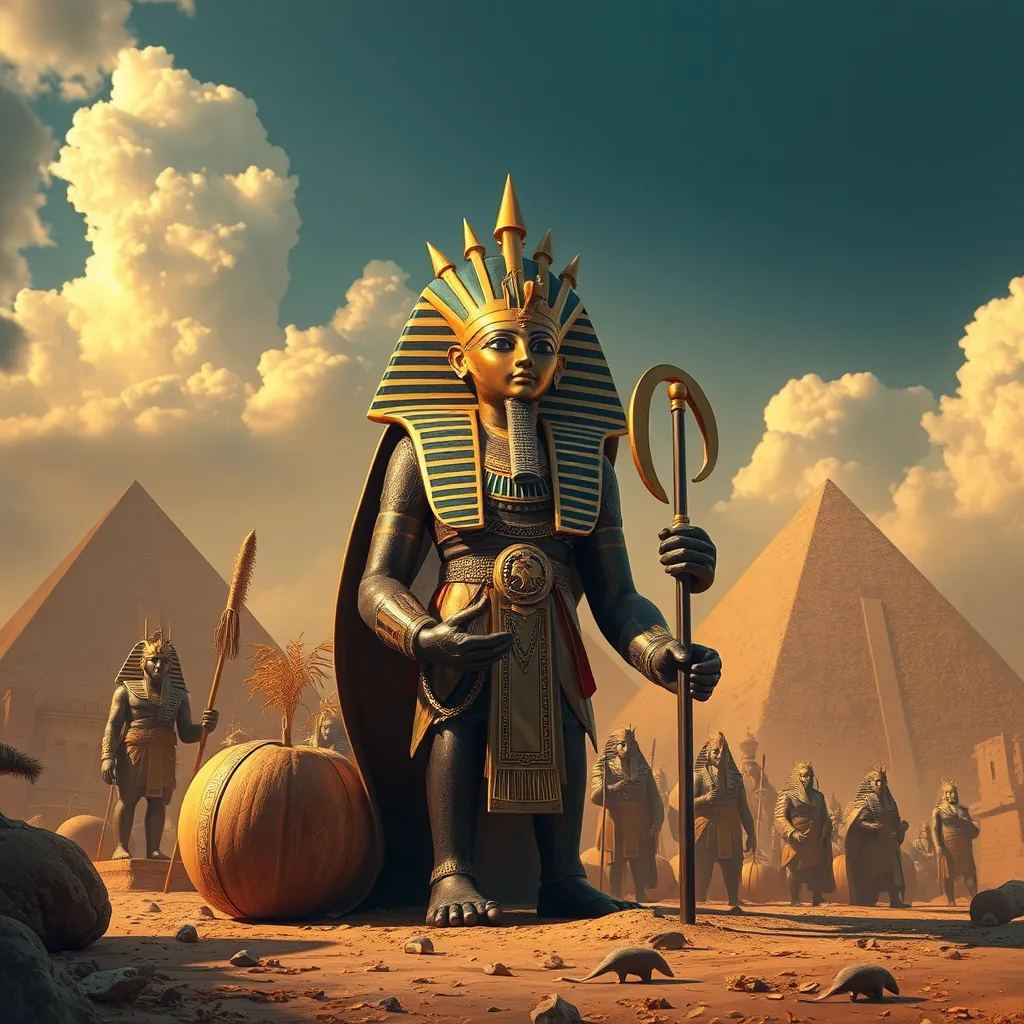The God of the Harvest: The Myth of Osiris and His Role in Providing for the People
I. Introduction
Osiris is one of the most significant deities in ancient Egyptian mythology, revered as the god of the afterlife, the underworld, and fertility. His narrative encapsulates themes of death, resurrection, and the cyclical nature of life, making him a central figure in Egyptian spirituality.
The importance of agricultural deities transcends cultures, as they often embody the essence of life and sustenance. In ancient societies, where agriculture was pivotal for survival, these gods were invoked to ensure bountiful harvests and food security.
This article aims to explore the multifaceted role of Osiris as the god of the harvest, examining his mythological background, the agricultural cycle, rituals associated with his worship, and his lasting legacy.
II. The Mythological Background of Osiris
Osiris’s origins are steeped in rich mythology. He is often depicted as the son of the sky goddess Nut and the earth god Geb. His siblings include Set, the god of chaos, and Isis, his devoted wife and sister. The dynamics within this divine family set the stage for key events that shaped Osiris’s narrative.
One of the most significant myths involves his death at the hands of Set, who coveted Osiris’s throne. After being betrayed and killed, Osiris’s body was dismembered and scattered across Egypt. However, with the assistance of Isis and their sister Nephthys, Osiris was resurrected, symbolizing not only his return to life but also the promise of rebirth for all.
As the god of the afterlife, Osiris presided over the judgment of souls, determining their fate in the afterlife. This role further accentuated his importance as a symbol of resurrection and the eternal cycle of life and death.
III. Osiris and the Cycle of Agriculture
Osiris is intricately linked to the agricultural cycle, embodying the principles of growth, decay, and renewal. The symbolism of his death and resurrection parallels the seasonal changes in farming, where crops die and are reborn each year.
The Nile River, often viewed as the lifeblood of Egypt, plays a crucial role in this cycle. Its annual flooding deposited nutrient-rich silt onto the fields, allowing crops to flourish. This phenomenon was seen as a manifestation of Osiris’s blessings, reinforcing the belief that he was the provider of agricultural abundance.
- Death and Resurrection in Farming: Just as Osiris died and was reborn, crops would die in the dry season and sprout anew with the arrival of the Nile’s floodwaters.
- Significance of the Nile: The river’s floods were viewed as a divine intervention from Osiris, ensuring the fertility of the land and the prosperity of the people.
IV. Rituals and Worship of Osiris
The worship of Osiris was deeply embedded in Egyptian culture, with various festivals dedicated to him marking the agricultural calendar. Notably, the Osiris Mysteries were celebrated annually, coinciding with the flooding of the Nile, symbolizing the death and resurrection of Osiris.
Offerings made to Osiris often included grains, fruits, and other agricultural products, reflecting the community’s reliance on him for sustenance. These practices aimed to ensure a bountiful harvest and express gratitude for his blessings.
The role of priests and temples was crucial in invoking Osiris’s favor. They conducted rituals that included:
- Performing rites to ensure the fertility of the land.
- Reciting prayers and hymns that praised Osiris’s contributions to agriculture.
- Creating offerings and altars adorned with symbolic items related to the harvest.
V. Osiris as Provider for the People
In ancient Egypt, Osiris was seen as a vital figure in ensuring food security. The annual cycle of planting and harvesting was directly tied to his mythology, emphasizing that the prosperity of the populace relied on his benevolence.
The agricultural success attributed to Osiris fostered a sense of community reliance on the harvest. This interconnectedness led to:
- A collective effort in farming practices and rituals.
- A strong cultural identity centered around the agricultural calendar.
- A societal structure that prioritized the worship of deities like Osiris for agricultural success.
VI. Comparative Analysis with Other Agricultural Deities
Osiris shares similarities with various agricultural deities from different cultures, reflecting a universal theme of fertility and sustenance. For instance, the Roman god Saturn and the Greek god Demeter also embody agricultural principles, emphasizing the cyclical nature of planting and harvesting.
However, Osiris’s mythology is unique in its profound connection to the afterlife and resurrection, setting him apart from other gods. His narrative illustrates the Egyptians’ understanding of death not as an end, but as a continuation of life, mirroring the agricultural cycle.
Cross-culturally, the significance of fertility and agricultural gods serves to highlight humanity’s intrinsic connection to nature and the rhythms of the earth.
VII. The Legacy of Osiris in Modern Times
The influence of Osiris extends beyond ancient Egypt into contemporary agricultural practices. Farmers and agriculturalists today still recognize the importance of seasonal cycles, which echo the ancient wisdom embodied by Osiris.
In popular culture, Osiris is often referenced in literature, art, and media, symbolizing themes of resurrection and hope. His image remains a powerful representation of the relationship between humanity and the cycles of nature.
Moreover, the myth of Osiris continues to resonate within modern spiritual contexts, where themes of rebirth and renewal are celebrated in various religious practices and beliefs.
VIII. Conclusion
Osiris’s role as the god of the harvest illustrates the profound connection between mythology and agriculture in ancient Egypt. His narrative encapsulates essential themes of life, death, and rebirth, providing a framework for understanding the agricultural cycles that sustained the civilization.
Reflecting on the importance of such myths offers insight into humanity’s enduring relationship with the earth and its resources. Osiris remains a relevant figure, reminding us of the cycles of life that continue to influence our understanding of spirituality and agriculture today.




